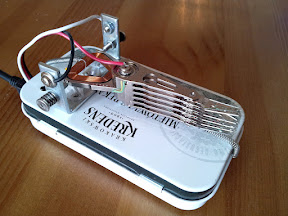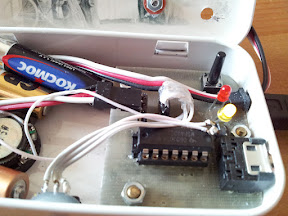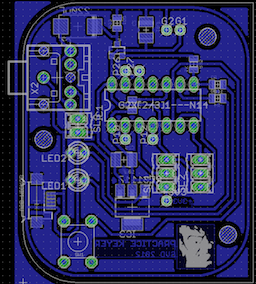A single-paddle automatic key for morse sending practice
May 26, 2012
This is a simple key for morse sending practice. It’s made from the ubiquitious mint tin, old HDD parts and screws, some springs and hardware store pieces. The key can function in manual and fully automatic mode thanks to MSP430-based automatic keyer. As designed, it’s not intended to be used as a real CW key, but it is very easy to convert it to be a “real” one.
The mechanical part uses a tin box for the base, to which a HDD head lever is attached. Practically all HDD heads are mounted on quality bearings with a threaded hub inside. This particular one has M2.5 threading. The contacts are made from a small metallic angles bought in a hardware store. Each angle has 2 screws on it: one to adjust the contact gap, another to attach a wire. The lever is held centered with the help of 2 springs.
The tin is metallic so to avoid short circuits all screws used in attachment of the key parts to the base were wrapped in plastic and non-conducting bushings were used. The wires could be connected from the bottom, but it was easier to keep them outside. For the key to be automatic, the static contacts are separate from each other. In manual mode, the controller just ignores which contact is currently closed. In automatic mode, one is used for sending dits, another for sending daws at fixed intervals.
The modes are switched with the help of a momentary switch button. To adjust the sending speed in auto mode, there is a potentiometer mounted on the side of the tin case. In manual mode the speed can’t be changed, so the potentiometer is used to set PWM duty cycle, thus making it possible to turn the volume down slightly for late-night practicing sessions. Headphones can also be used.
The firmware is written in C. The device and firmware were prototyped on TI Launchpad. There is no programming interface on the keyer board. For every reprogramming the chip has to be inserted in the Launchpad. This would be too oldskool to be practical if I had started development like so from the scratch, but it wasn’t a problem because most everything was prototyped and debugged while the chip was still in the Launchpad.
Pictures
Here are some pictures that show the details. The batteries there do nothing but add weight to prevent that it slides on the table when being used.


The code
The code is very basic. To be honest, I hate MSP430, especially the chips that were included with the Launchpad. It was gathering dust for a long time, waiting to be useful at least for something. This project seems to be the adequate use for it though, finally I could remove it from my sight for good. The program really can’t be called work of love, it is based on a couple of examples that I’ve found on the net: one for the basic clock and I/O setup and another for ADC routines. It is not recommended that you pick your MSP430 knowledge from this piece, better search for something written with a bit of care.
The schematics and the board

This is one of the most basic circuits I have ever done. It fits on one side without a single jumper wire. It should be very easy to reproduce, but in reality this isn’t even necessary: the Launchpad itself is a board good enough, even better now that it has a programming interface. But I like making my own boards.
Files
Helpful links
These articles helped me with the code for MSP430:
Happy practicing!